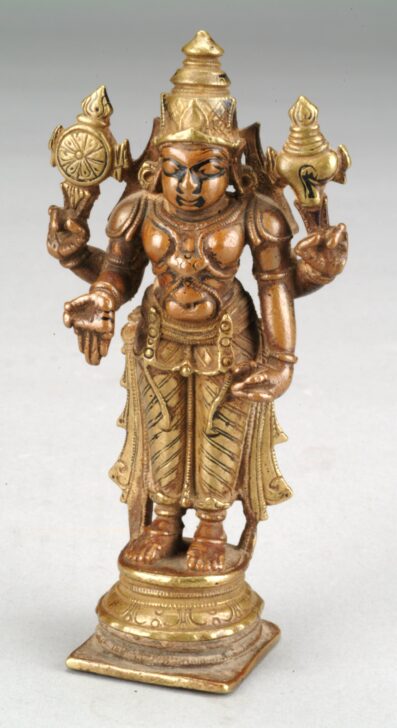Vishnu as Bhogasthanakamurti, accompanied by a pair of female attendants, 1978/2.131 and 1978/2.132
Indian

Description
March 28, 2009
“So my mind touches the lotus feet of Ranga’s Lord (Vishnu), delights in his fine calves, clings to his twin thighs and, slowly rising, reaches the navel.” It was in sensual, even erotic, terms such as these that poet–saints described the effects of Vishnu’s image almost a millennium ago. The image was believed to capture the essence of the deity, and such ecstatic contemplation of the god’s physical body was seen as an important means of approaching the divine. This small bronze image of Vishnu was clearly beloved by its beholders; its face and torso shine from the hands of devotees who rubbed it repeatedly, anointing it with oils and sweet fragrances. Vishnu is portrayed as a resplendent king, his body straight and symmetrical in contrast to the sinuous bodies of his two consorts, who are drawn to his magnificence.
(Label for UMMA South and Southeast Asia Gallery Opening Rotation, March 2009)
Subject Matter:
Vishnu is one of the principal gods of Hinduism, along with Shiva and the goddess, and commands a large following. He is often depicted with four arms and consistently carries four attributes: the discus, conch, club and lotus.
Three bronzes form a group: Vishnu 1978/2.123, Bhudevi 1978/2.132 and Shridevi 1978/2.131
Physical Description:
Vishnu stands on a base consisting of a flat square element topped with a series of five round rings. He stands in an unbending pose and has four arms. Reading clockwise from his front right hand, he is in varada mudra, holds a discus, holds a conch, and is on his hip. He wears a decorated lower garment flared out on either side in a pattern. He wears a decorated belt and necklaces, a sacred thread and shoulder loops, bracelets and armlets, earrings and a crown. The jewelry and crown is highlighted with gold paint as is his clothing and the two attributes.
Usage Rights:
If you are interested in using an image for a publication, please visit https://umma.umich.edu/request-image/ for more information and to fill out the online Image Rights and Reproductions Request Form.